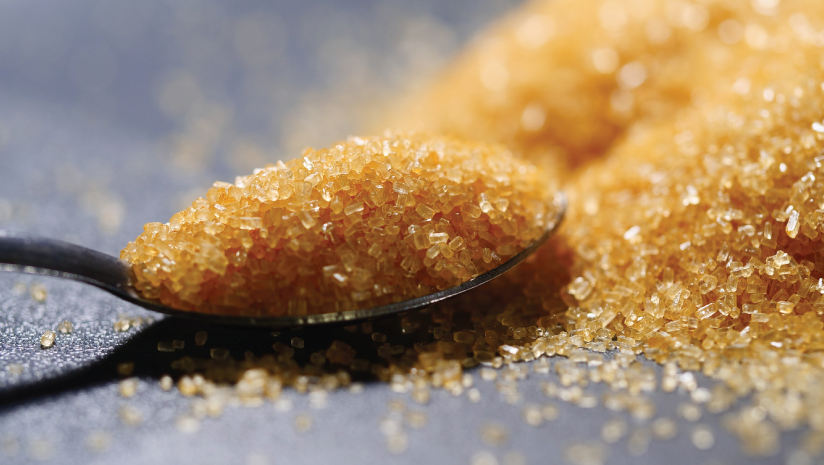- MOST RECENT
Brown Sugar: Manufacturing Process - 24 Mantra Organic

An In-Depth Look at How Brown Sugar is Made
 25.11.2020
25.11.2020
We have all come across small packers of brown sugar in coffee shops and bakeries, but what exactly are they? Where do they come from? How is brown sugar made? And do we need them? Let’s aim to fight a few of these questions here below:
What is Brown Sugar?
This sugar, found in both granular crystals and powder forms, is recognised as the healthier alternative to sugar. An acquired taste for many, this is the combination of molasses to sugar which gives sugar it’s distinct colour and name.
The brown sugar that you buy for daily use is supposed to contain around 2.5% molasses in the light variation and approximately 6.5% molasses in the dark variety. The sugar used in commercial factories for making baked goods in mass qualities has around 10% a combination of molasses.
These varied levels of molasses are useful for different tastes, texture, and purposes. All of these variables come to form the same questions: how is brown sugar made in so many options?
How is brown sugar made?
The preparation of brown sugar, in the simplest form, is the addition of molasses into white sugar. This combining is done without the many stages of refinement; making it a rawer and healthier version of sugar. Let’s take a close look at how is brown sugar made:
For making both regular and brown sugar, the first step is extracting the juices from sugarcane or sugar beet. This occurs from sophisticated extraction processes. After this juice is removed, they are boiled and purified to a point where a brown syrup-like substance transpires. This substance is called molasses.
Is this molasses that makes your candy hard during baking, or added gives the texture to alcohol when added into rum. The molasses is also the primary source of energy in cattle feed and the production of vinegar.
Coming back to how is brown sugar made; the crystalized sugar achieved from the previous step is taken aside from the molasses—this composition is centrifuged. Centrifugation is a process where the substances undergo a considerable amount of spinning force. By this, the materials of different densities separate.
Using this process, we get sugar crystals. This combination filters again and is washed in the presence of bone ash. It is this ash that gives the sugar it’s white colour.
At this point, we understand how is brown sugar made. The refined brown sugar is nothing but the molasses (previously removed) added back to the mixture before the exposure to bone ash. Which means they are less processed and rich in molasses.
The combination is allowed to mix until the desired colour, texture, and finish are archived. These are then packed and shipped to you at your nearby organic store in a clean and air-tight package.
But do you know that brown sugar is prepared at home? Let’s take a look at how is brown sugar made at home.
Homemade Brown Sugar
If you look online, you can find many suppliers selling edible molasses– usually sold to baking kitchens. You can combine these molasses to regular sugar in your home to make brown sugar easily.
To make light brown sugar use one cup of sugar, with one teaspoon of molasses. For a darker finish, use two teaspoons of molasses. Combine the two in a mixing bowl and use your hands to rub them into each other. The more you rub it, the better they incorporate together. Ensure you save them in an air-tight container and use them within the month.
Best Source for Brown Sugar?
Now that you know how is brown sugar made at home and the factory, how do you know which one is better? The trick is not in the process; it is in the ingredients. We cannot always turn our sugar and molasses sources. Small contamination in the origins can lead to long-term damage to your heart, kidney, and liver.
The best way to get your brown sugar is to form an organic outlet. They ensure to keep a check at every step of the way. Organic companies can ensure there are no additives, preservatives, or chemicals. This process also proves a higher level of antioxidants and better shelf-life.
One advantage we cannot ignore is the benefits to the farmers. The organic products ensure the farmers are given more for their produce. This help allows them to farm the crops, in this case– sugarcane, in a clean and environmental friendly way.
In Application
Baking companies and kitchens are the top users of brown sugar. Since the presence of molasses gives a better texture, it has become the go-to choice. If you are looking for a toffee-like flavour or a glossy finish, then the use of brown sugar is a perfect alternative.
After seeing how is brown sugar made, you can infer that it is the molasses that gives it the perfect baking finish most chefs are looking for. However, the nutrition from them is just like regular sugar.
Final Thoughts
Suppose you are looking to jump into using brown sugar in your daily diet, it is an acquired taste. The brown sugar can alter the colour and the sweetness of your beverage or dish. So if you are someone who enjoys the taste, you must give it a shot.
At the end of the day, brown sugar is also sugar. So use it in a regulated amount. No matter how many added minerals, it does not make it free from the harms of sugar intake.
Try 24 Mantra Organic’s Brown Sugar and savour the taste of organic goodness.


